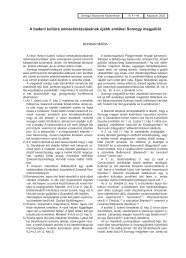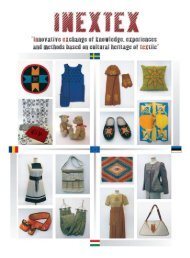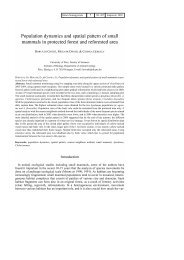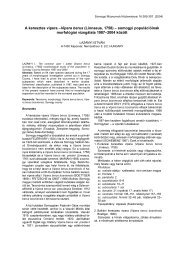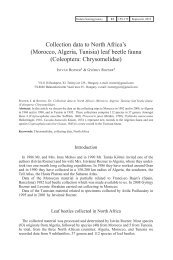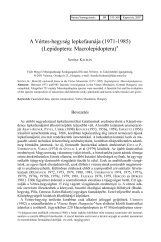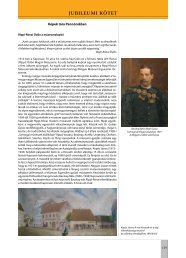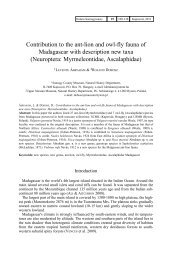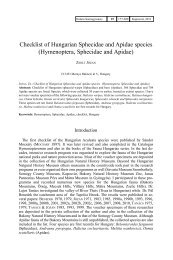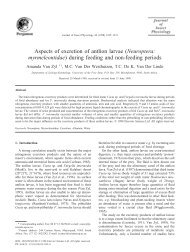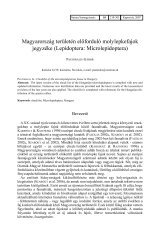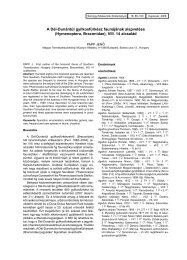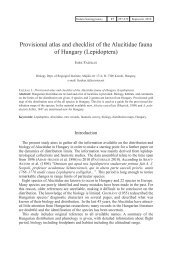Study on the Palaearctic Pristiphora species (Hymenoptera ...
Study on the Palaearctic Pristiphora species (Hymenoptera ...
Study on the Palaearctic Pristiphora species (Hymenoptera ...
Create successful ePaper yourself
Turn your PDF publications into a flip-book with our unique Google optimized e-Paper software.
220<br />
NATURA SOMOGYIENSIS<br />
sometimes hind margin of pr<strong>on</strong>otum and <strong>the</strong> last abdominal segment may whitish or<br />
brownish. Legs whitish or whitish brown. Coxae, more or less hind side of fore femora,<br />
most of hind femora, apices of hind tibiae and tarsi black. Fr<strong>on</strong>tal area definitely outlined.<br />
Mesopleur<strong>on</strong> shiny. Wings hyaline, costa light brown, stigma brown or dark<br />
brown. Face normal, Fig. 165].........................................................P. geniculata (Hartig)<br />
Hungary, Austria, Belgium, Switzerland, Czech, Germany, Denmark, England, France, Italy, Ireland,<br />
Ne<strong>the</strong>rlands, Romania, Sweden, Slovakia, Finland, Northwest and West Russia, Nor<strong>the</strong>rn Caucasus, Tien<br />
Shan, Kamtchatka, China and North America.<br />
- Tegula with white margin. Abdomen wholly black. Antenna as l<strong>on</strong>g as abdomen. Saw<br />
with apical bristles. 6.0-7.5 mm.........................................P. pseudogeniculata Lindqvist<br />
Russia: Kamtchatka and Finland.<br />
6.Hind femur light coloured, whitish or ochraceous-whitish. Mesopleur<strong>on</strong> lustrous...7.<br />
- Hind femora extensively black. Mesopleur<strong>on</strong> variable...........................................13.<br />
7. Hind femora entirely white except its extreme bases and apices.............................8.<br />
- Basal third of hind femora white. 5.5 mm. Fig. 217..............................P. zh<strong>on</strong>gi Wei<br />
Known from China.<br />
8. Claws nearly bifurcate, with large denticle. Stigma dark brown, costa pale brown.<br />
Head with scattered punctuati<strong>on</strong>. Inner spur of hind tibia half as l<strong>on</strong>g as basitarsus. 5.5 mm<br />
............................................................................................................P. leucopa Hellen<br />
Central and Southwest Russia, Ukraine, Slovakia, Denmark and Finland.<br />
Claws without or with denticle but never bifid............................................................9.<br />
9. Claws without denticle...........................................................................................10.<br />
- Claw with denticle....................................................................................................11.<br />
10. Head with scattered punctures, shiny. Inner spur of hind tibia half as l<strong>on</strong>g as<br />
basitarsus. [Black. Labrum, tegula, underside of antenna, sometimes hind corners of<br />
pr<strong>on</strong>otum, more or less <strong>the</strong> hypopygium light yellowish brown. Legs yellowish white.<br />
Apex of hind tibia and hind tarsus darkened.] 5.5 mm. Light colour variati<strong>on</strong> from Japan<br />
in Fig. 221........................................P. appendiculata Hartig (syn. P. pallipes Lepeletier)<br />
One of <strong>the</strong> comm<strong>on</strong>est <strong>Pristiphora</strong> <strong>species</strong>. All Europe, Russia up to Vologda and Karelia in <strong>the</strong> North,<br />
Russian Far East, Asia Minor, M<strong>on</strong>golia, China, Japan and North America.<br />
- Head densely punctate. Inner spur of hind tibia 1/3x as l<strong>on</strong>g as basitarsus. [Black.<br />
Corners of pr<strong>on</strong>otum and tegulae dirty white. Femora, tarsi and tibiae yellowish. Hind<br />
tibia, except its apex whitish. Hind tarsus (except metatarsus) brown. Bases of femora<br />
with narrow line. Wings subhyaline. Venati<strong>on</strong> brown. Middle part of costa brown, base<br />
and apex light coloured. Stigma pale yellow with lighter basal part and little darker<br />
apex.] 4.0 mm..............................................................................P. aspericeps Lindqvist<br />
Finland.<br />
11. Sawsheath in Fig. 33. [Variously coloured. Legs extensively yellowish white. Hind<br />
tibial apex and hind tarsus darkened. Hind femur sometimes with brown l<strong>on</strong>gitudinal<br />
strips. Specimens with extensively brown hind femur frequently occur. Tegula, most of<br />
<strong>the</strong> pr<strong>on</strong>otum, labrum, clypeus, last abdominal tergite whitish. Abdominal sternites variously<br />
coloured, sometimes <strong>on</strong>ly <strong>the</strong> apical sternit, sometimes most of <strong>the</strong> sternites light<br />
coloured. Fig. 193, 194 and 122. Mes<strong>on</strong>otum finely punctured. Mesopleur<strong>on</strong> finely,<br />
densely punctured,subshiny. Wings hyaline, stigma and costa yellow. Sawsheath typical<br />
for <strong>the</strong> <strong>species</strong> as it figured in Figs. 33 and 55. However, in lateral view, <strong>the</strong> acute projecti<strong>on</strong><br />
of <strong>the</strong> sawsheath sometimes hardly visible]. 4.0-5.5 mm.<br />
....P. insularis Rohwer (syn. n. P. kamtchatica Malaise, syn. n. P. mesatlantica Lacourt)<br />
Hungary, Austria, Belgium, Switzerland, Czech, Slovakia, Germany, France, England, Scotland, Italy,<br />
Ireland, Russia: Magadan regi<strong>on</strong>, Kamtchatka, Karelia, Finland and Japan.<br />
- Sawsheath different, like Fig. 2................................................................................12.



